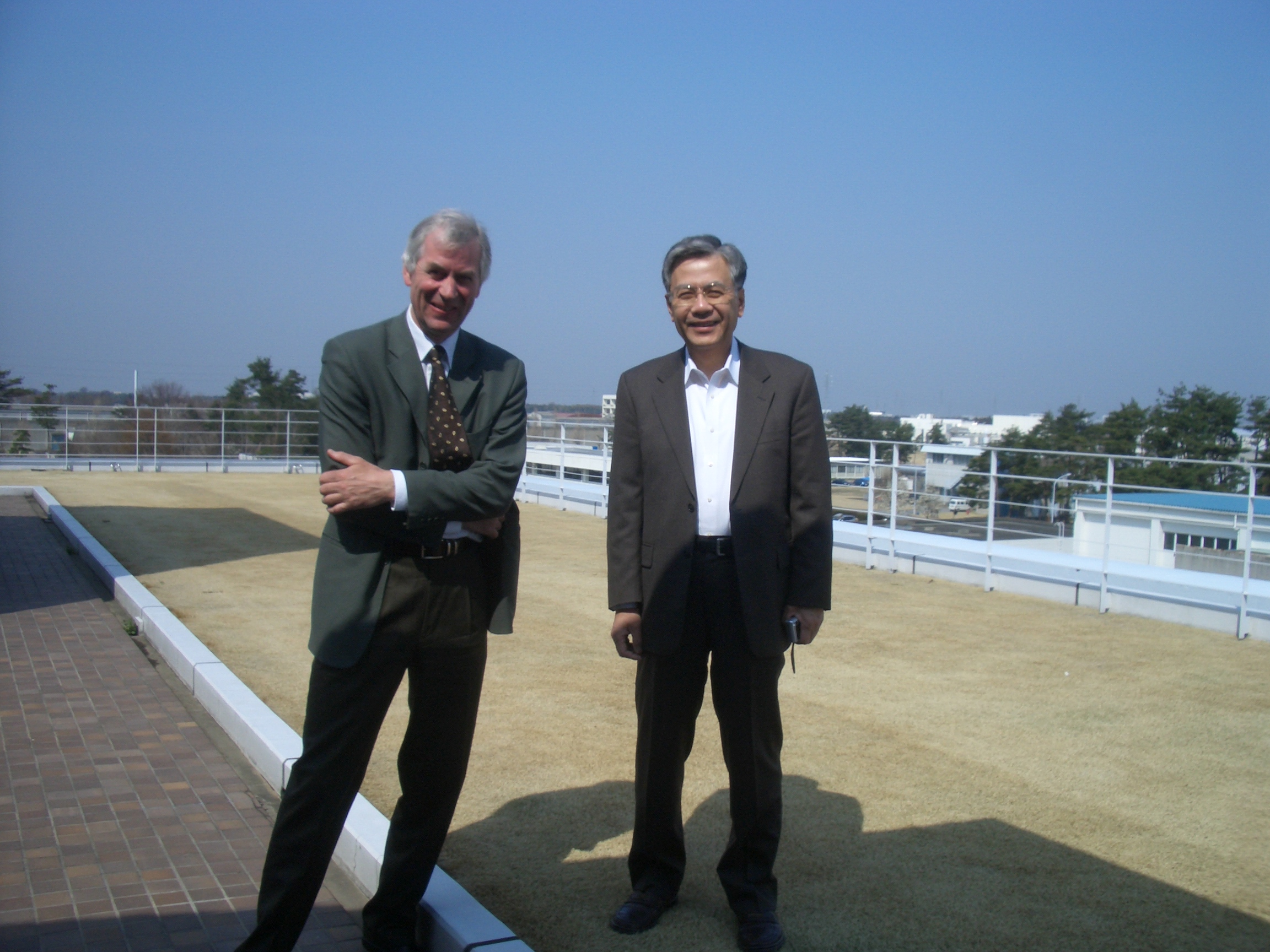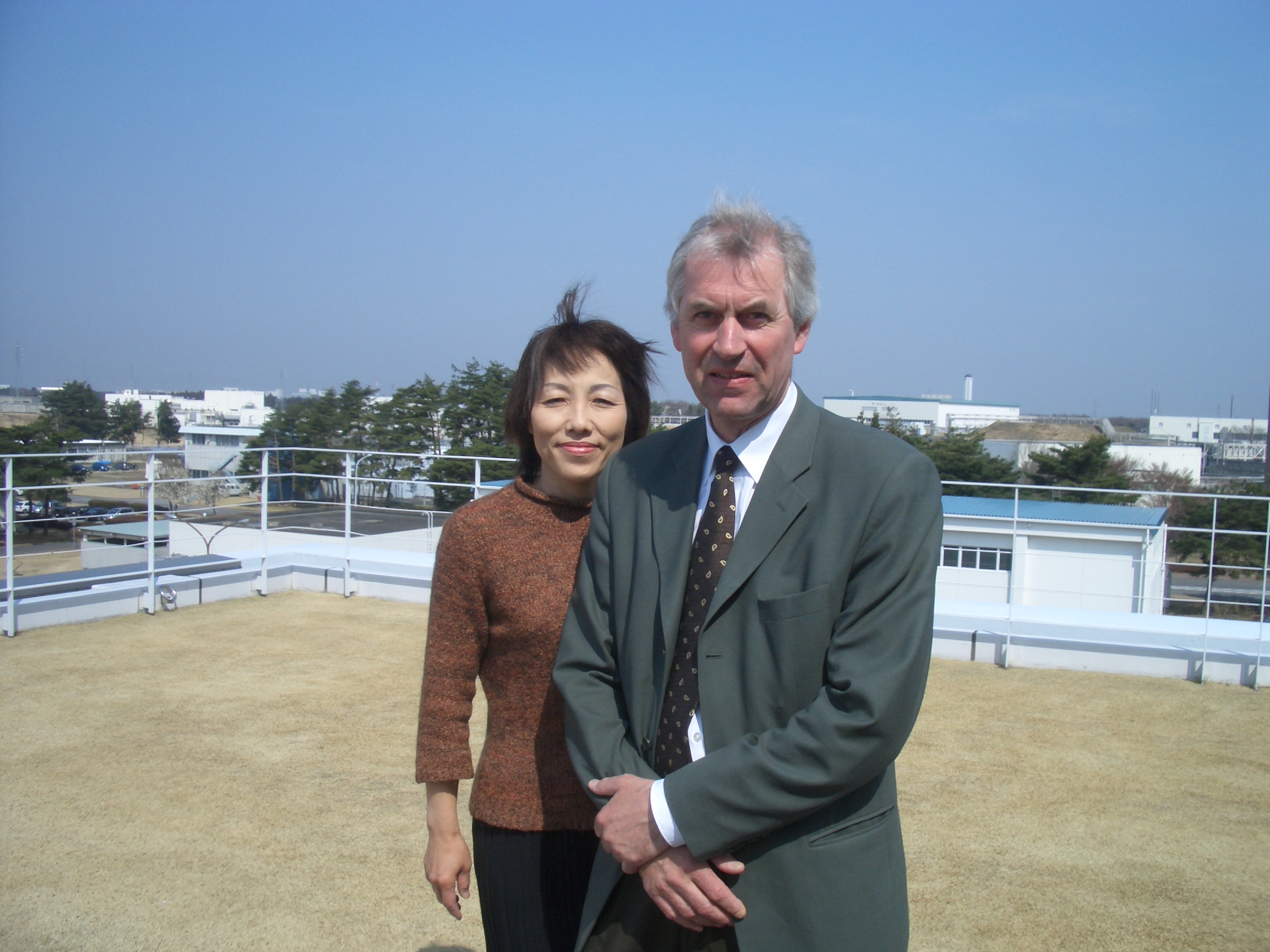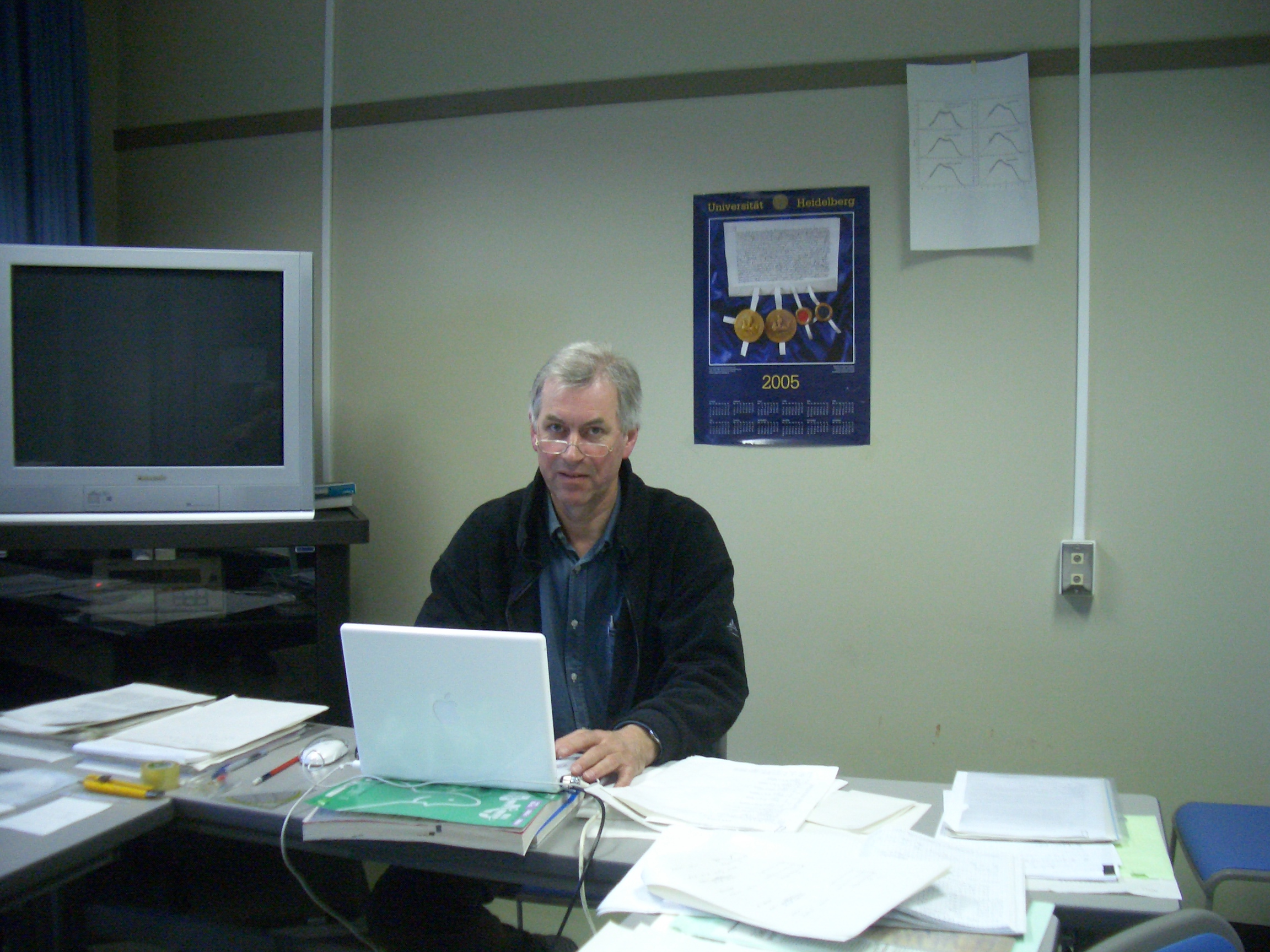JSPS INVITATION FELLOWSHIP FOR RESEARCH IN JAPAN
RESEARCH REPORT Feb 12 - Apr 10, 2005 ID NO S 04755
(a) Outline of academic activities
(a-1) It has been the main purpose of my stay in Japan to bring together the
theoretical research that I had started 1996-99 in Relativistic Heavy
Ion physics [1, GW], and the corresponding subsequent works of my japanese
colleagues in Matsumoto and Toba, M. Biyajima et al. [2, MB]. For this purpose, I first identified a
current research problem in this field, and then used the theoretical apparatus that we had built up
so far, but also new developments to tackle it with the support of, and in collaboration with my
japanese colleagues. The following text gives a brief outline of the activities. [Readers who are not
interested in these details should continue with (a-2)].
The Relativistic Diffusion Model (RDM) had originally been developed for, and applied to net
baryons in reactions at SIS, AGS, SPS and RHIC energies for symmetric and asymmetric systems
by GW. It had been redeveloped, and applied to produced charged hadrons at RHIC energies by
MB. For participant baryons, this approach with two sources gives excellent results at
comparatively low energies (SIS, AGS, SPS up to 17 GeV center-of-mass energy per particle pair).
At RHIC energies of 200 GeV, however, the two-sources RDM fails to produce the relatively high
midrapidity yield that has been found by the STAR, BRAHMS, and PHOBOS Au+Au
experiments. Hence, it has been proposed by GW to superpose the nonequilibrium solution of the
RDM with a locally equilibrated midrapidity source. All three sources are found to expand
collectively with about v=0.9 c in longitudinal direction, and roughly 14% of the net baryons are
included in the equilibrated midrapidity region [3].
The MB-group has also extended the RDM for produced charged particles to three sources at RHIC
energies. For Au+Au they find that about 78% of the produced charged hadrons in central collisions
are locally equilibrated in pseudorapidity space at 200 GeV, corresponding to nearly 4000 charged
particles; the other particles remain in the non-equilibrium region. Since
according to the
Standard Model of particle physics- new particles are generated in form of quarks and gluons,
which then hadronize, one may tentatively conclude that a very large fraction of the produced
partons had been in a locally equilibrated state (a quark-gluon plasma) before
hadronization.
Both findings combined indicate that the Au+Au system at RHIC energies of 200 GeV per particle
pair has produced a transient locally equilibrated quark-gluon plasma
that lives for about 10^-24 sec.
Since it is generally believed that quark-gluon plasma formation is much less important in small
asymmetric systems at the same incident energy per particle, I decided to investigate this conjecture
within the RDM-framework during my stay in Japan. For asymmetric systems, however, the third
source is not centered precisely at midrapidity (y=0) but instead it is moving, and the analytical
non-equilibrium statistical treatment becomes more involved.
A suitable asymmetric system for which very recent RHIC data are available is d + Au
at 200 GeV per particle. The PHOBOS collaboration has assembled very accurate
pseudorapidity distributions for produced charged particles as function of centrality (submitted to
PRC). In my work at Shinshu University I started to compare these results with the analytical
RDM-solutions in the three-sources-model, going from central to peripheral collisions. In
discussions with my japanese colleagues (MB, NS) a suitable form for the centrality-dependence of
the equilibrium value of the rapidity was found. The parameters in the analytical solution of the
problem were finally optimized in a numerical minimization procedure using a Fortran code (TM),
thereby considering the transformation from rapidity to pseudorapidity space.
The outcome of this project is an extremely precise representation of the PHOBOS data for d + Au
in the three-sources RDM. This allows the conclusion that a locally equilibrated region exists also in
case of this light and asymmetric system, but it contains only 17% of the produced particles. Hence,
although a partonic plasma in local thermal equilibrium is less important as compared to the heavy
Au+Au system, it is likely to exist.
[1] G.Wolschin, Eur. Phys. J. A5 (1999) 85; Phys. Rev. C69 (2004) 024906.
[2] M. Biyajima, M. Ide, T. Mizoguchi and N. Suzuki, Prog.
Theor. Phys. 108, (2002) 559;
Addendum 109, (2003) 151;
M. Biyajima, M. Ide, M. Kaneyama, T. Mizoguchi
and N. Suzuki, Prog. Theor. Phys. Suppl. 153, (2004) 344.
[3] G. Wolschin, submitted to Phys. Lett. B; see also
Nucl. Phys. A 752C (2005) 484, and
N. Suzuki and M. Biyajima, hep-ph/0504076.
[4] G. Wolschin, M. Biyajima, T. Mizoguchi, and N. Suzuki, hep-ph/0503212.
(a-2) Universities and research institutions visited during my JSPS-term at
Shinshu University, Matsumoto Feb 12-April 10
[1] Yukawa Institute, Univ. of Kyoto Feb 21-26
[2] Tokyo University of Science, Noda Mar 23-27
[3] J-PARC (S. Nagamiya, S. Sato, M. Yoshioka), Tokai Apr 4
[4] KEK (S. Nagamiya,, S. Sawada), BELLE (J. Haba); Tsukuba Apr 5-6
[5] Tohoku Univ.; Electron accelerator (T. Ohtsuki); Cyclotron Lab.
(T. Shinozuka); Theory department.
I have submitted some photographs taken during my academic activities to my host as you have
requested.
(a-3)Conference and Seminar talks with discussions in Japan:
[1] Diffusion and local deconfinement in relativistic systems.
YITP-workshop, Yukawa Institute, University of Kyoto, 22.02.2005
(invitation by T. Kunihiro, YITP, and H. Fujii, Tokyo Univ.)
[2] Relativistic Diffusion Model.
Shinshu University, Matsumoto, 10.03.2005 (invitation by M. Biyajima)
[3] Relativistic Diffusion Model analysis of d + Au collisions.
JPS-meeting Noda, 24.03.2005
[4] Diffusion in relativistic systems.
KEK, Tsukuba, 5.04.2005 (invitation by S. Nagamiya)
[5] Heavy-ion collisions at low and high energies.
Tohoku University, Sendai, 6.04.2005 (priv. seminar, inv. by F. Takagi,
Ishinomaki Senshu Univ., and M. Maruyama, Tohoku University)
(a-4) Summary of scientific work performed at Shinshu University:
G. Wolschin, M. Biyajima, T. Mizoguchi, and N. Suzuki, hep-ph/0503212
and references therein.
__________________________________________________________________________
(b) Impressions and thoughts on the present state of science in Japan
in my field:
The main part of my stay in Japan was at Shinshu University in Matsumoto,
which is one of the medium-size public universities; it was established in 1949 as a national
university. It has eight faculties on five campuses, two of which are in Nagano and one in
Matsumoto. There are about 10000 undergraduate students, 2100 graduate students and about 2000
academic and administrative staff. The physics faculty has 16 (presently 14) members.
Due to a high teaching load, many administrative responsibilities, decreasing funds and a lack of
personal and material resources it seems difficult to maintain a high standard of research that would
allow for a fruitful competition and cooperation with big public (Kyoto, Tokyo, Tohoku) and private
universities in Japan. There are, however, sections in good shape (such as the efficient computer
center and the Atlas-group headed by T. Takeshita).
In the areas that I had a chance to survey it appears that the main emphasis is on the education of
students. Since teaching on both undergraduate and graduate level is in japanese language, the
communication between foreign researchers and japanese students, and the ability of japanese
graduates to continue abroad, often remain very limited. To improve this, several graduate courses
in each faculty held in english language would appear to be helpful.
The bigger and better equipped public universities that I had a chance to visit such as Kyoto, Tokyo
and Tohoku can certainly compete and cooperate much better on the international level. But still, I
have seen great difficulties to get approval and funding for meaningful research projects.
On the other hand, there is an intense concentration and activity in national centers such as KEK
and J-PARC (S. Nagamiya), where top-level research is being, or will be performed. The BELLE
collaboration for the investigation of CP-violation in the B-meson system at KEKB celebrated a
landmark 400 fb^-1 this April and is now operating the worldwide leading facility in this area. The
K2K experiment had already provided most interesting results in neutrino physics. In this field,
Japan traditionally has a leading role in the world (S-Kamiokande, KamLAND), and it will be
improved substantially once J-PARC is operating. Obviously, the other fields which will be opened
up by J-PARC (neutron spallation source: materials and life science facility, hadron facility etc.)
will contribute to Japans leading role on an international level.
(c) Comments or suggestions to JSPS, especially concerning the
Fellowship program:
The Fellowship program is extremely useful and fruitful. I am impressed
by the rapidity of the positive reaction of the JSPS
administration to my fellowship application via
the daad.
_____________________________________________________________
(d) Other comments:
Regarding the exchange of students between Europe and Japan, I learned at the
annual meeting of the JSPS-Fellows in Bonn (April 2005) that only 3.1 % of the foreign students in
Japan come from Europe - the vast majority comes from Asia, mostly China. If there exists an
interest to intensify the exchange also on this level, the japanese-language abilities of european
students should be improved.
Bild 1: S. Nagamiya, KEK

Bild 2: Yumiko Iwamoto, KEK

Bild 3: Shinshu University, Japan

 return
return